Impact of Organizational Structure and Culture on Business Performance
VerifiedAdded on 2023/06/18
|11
|3122
|393
Report
AI Summary
This report examines the organizational structure and culture of Mango, an apparel and accessories company. It discusses different types of organizational structures and cultures, analyzing how they influence company behavior and individual workplace behavior. The report covers functional, hierarchical, flat, divisional, and matrix structures, along with clan, adhocracy, market, and hierarchy cultures. It explores how organizational culture and structure impact organizational performance, including managerial decision-making and employee motivation. Furthermore, it identifies factors such as personal characteristics (biographic and learned), environmental factors (employment level, wage rates, economic environment), and organizational factors (physical facilities) that influence individual behavior in the workplace, ultimately affecting the company's overall success. The report also offers recommendations to improve organizational performance.
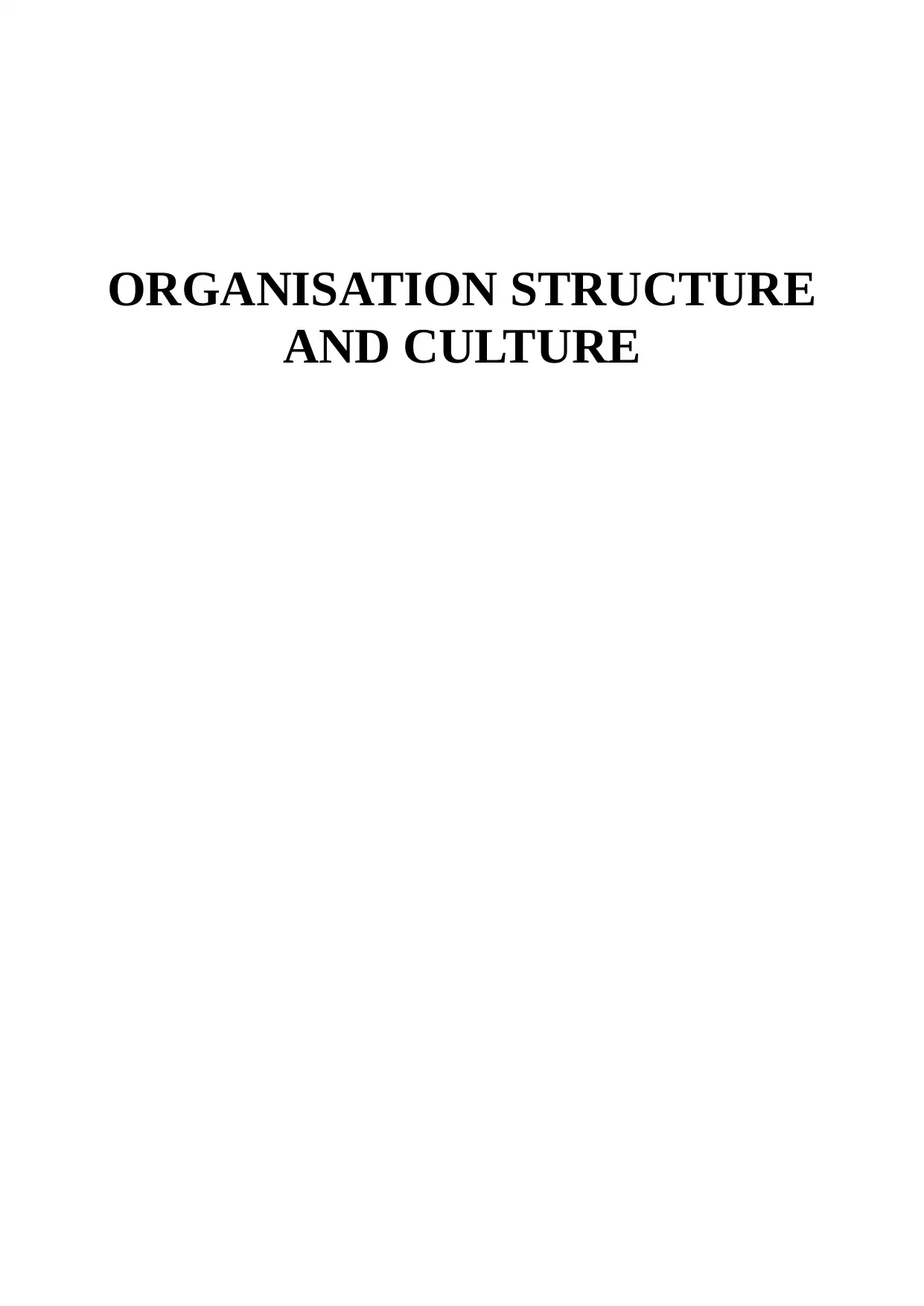
ORGANISATION STRUCTURE
AND CULTURE
AND CULTURE
Paraphrase This Document
Need a fresh take? Get an instant paraphrase of this document with our AI Paraphraser
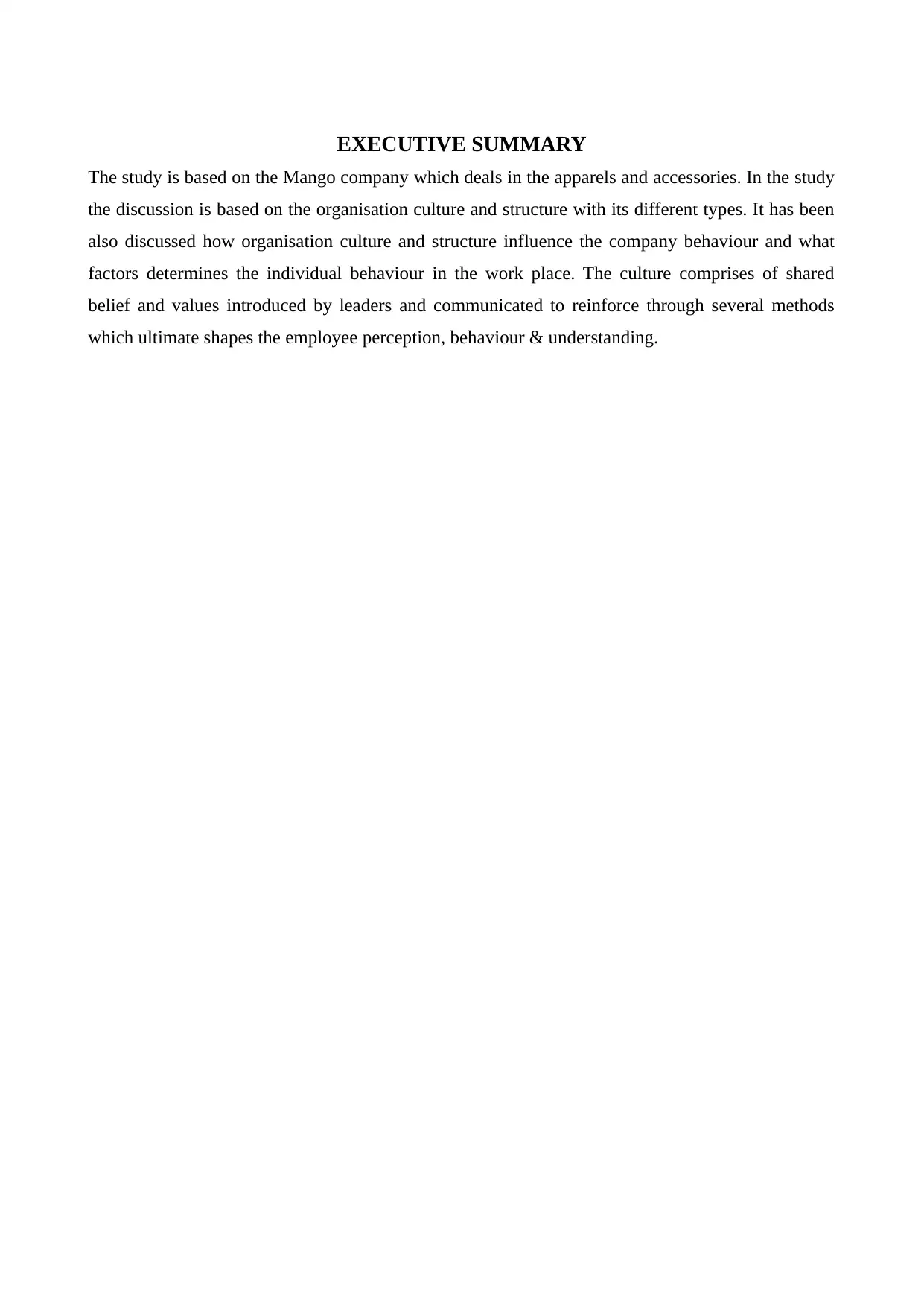
EXECUTIVE SUMMARY
The study is based on the Mango company which deals in the apparels and accessories. In the study
the discussion is based on the organisation culture and structure with its different types. It has been
also discussed how organisation culture and structure influence the company behaviour and what
factors determines the individual behaviour in the work place. The culture comprises of shared
belief and values introduced by leaders and communicated to reinforce through several methods
which ultimate shapes the employee perception, behaviour & understanding.
The study is based on the Mango company which deals in the apparels and accessories. In the study
the discussion is based on the organisation culture and structure with its different types. It has been
also discussed how organisation culture and structure influence the company behaviour and what
factors determines the individual behaviour in the work place. The culture comprises of shared
belief and values introduced by leaders and communicated to reinforce through several methods
which ultimate shapes the employee perception, behaviour & understanding.
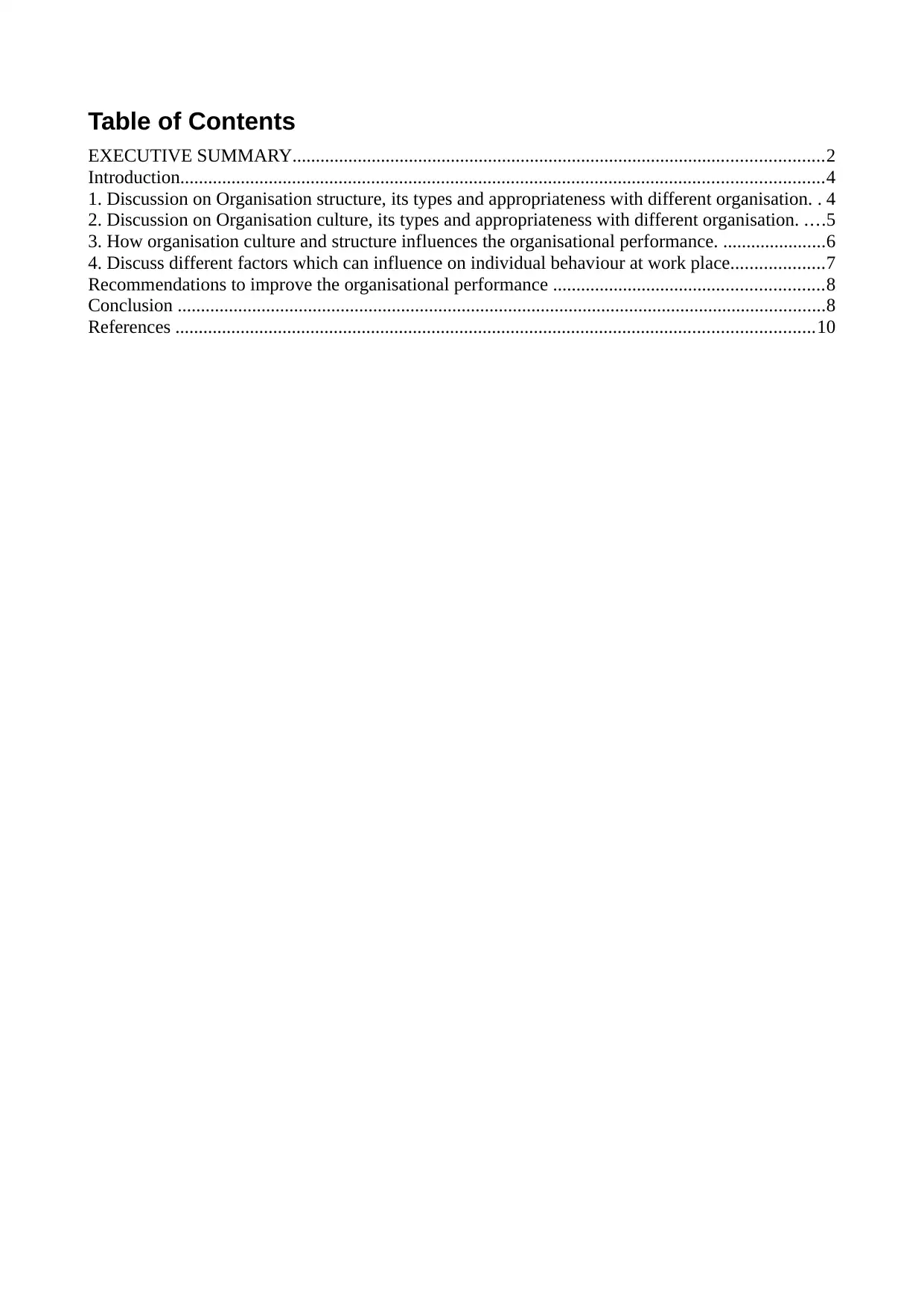
Table of Contents
EXECUTIVE SUMMARY..................................................................................................................2
Introduction..........................................................................................................................................4
1. Discussion on Organisation structure, its types and appropriateness with different organisation. . 4
2. Discussion on Organisation culture, its types and appropriateness with different organisation. ....5
3. How organisation culture and structure influences the organisational performance. ......................6
4. Discuss different factors which can influence on individual behaviour at work place....................7
Recommendations to improve the organisational performance ..........................................................8
Conclusion ...........................................................................................................................................8
References .........................................................................................................................................10
EXECUTIVE SUMMARY..................................................................................................................2
Introduction..........................................................................................................................................4
1. Discussion on Organisation structure, its types and appropriateness with different organisation. . 4
2. Discussion on Organisation culture, its types and appropriateness with different organisation. ....5
3. How organisation culture and structure influences the organisational performance. ......................6
4. Discuss different factors which can influence on individual behaviour at work place....................7
Recommendations to improve the organisational performance ..........................................................8
Conclusion ...........................................................................................................................................8
References .........................................................................................................................................10
⊘ This is a preview!⊘
Do you want full access?
Subscribe today to unlock all pages.

Trusted by 1+ million students worldwide
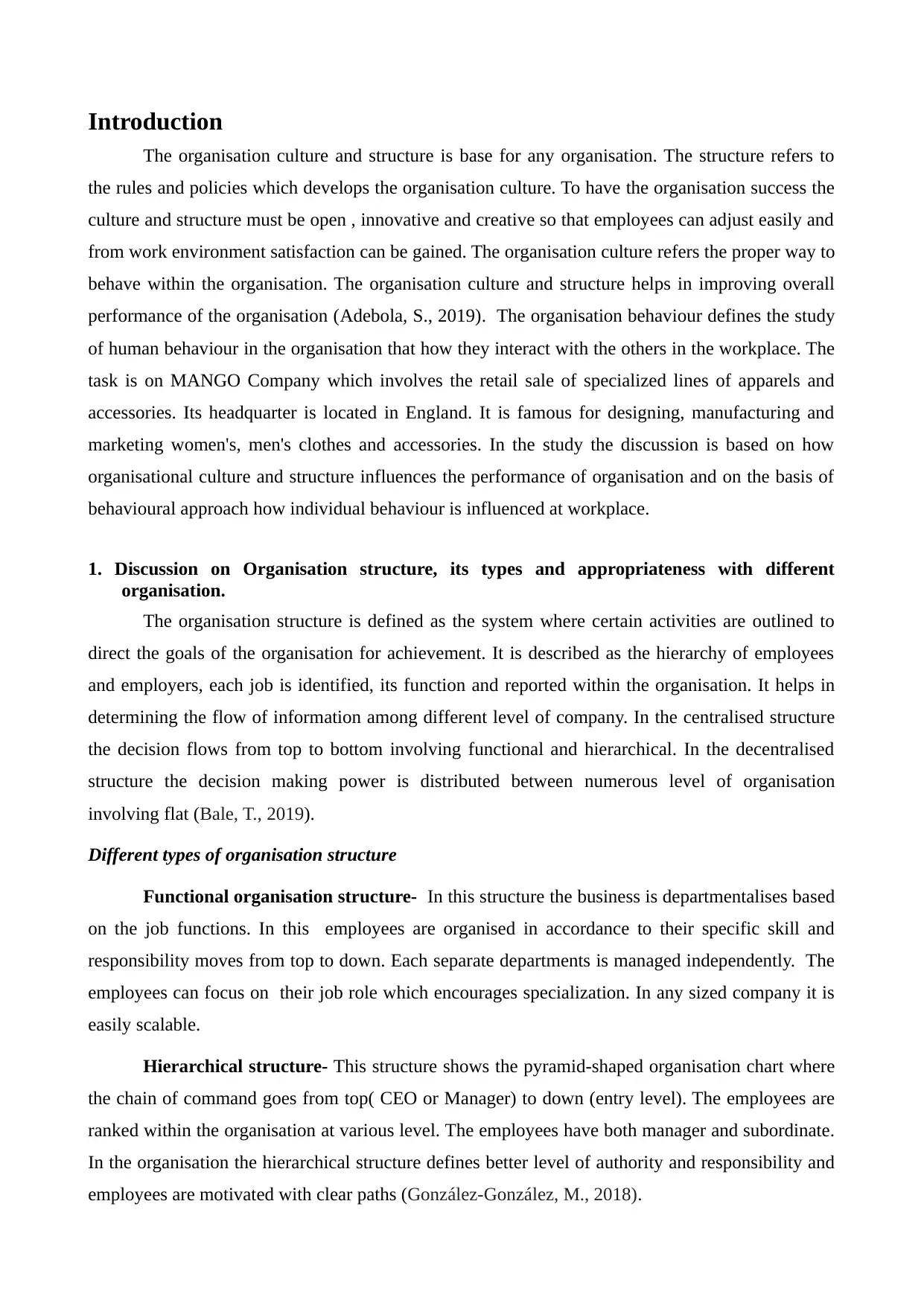
Introduction
The organisation culture and structure is base for any organisation. The structure refers to
the rules and policies which develops the organisation culture. To have the organisation success the
culture and structure must be open , innovative and creative so that employees can adjust easily and
from work environment satisfaction can be gained. The organisation culture refers the proper way to
behave within the organisation. The organisation culture and structure helps in improving overall
performance of the organisation (Adebola, S., 2019). The organisation behaviour defines the study
of human behaviour in the organisation that how they interact with the others in the workplace. The
task is on MANGO Company which involves the retail sale of specialized lines of apparels and
accessories. Its headquarter is located in England. It is famous for designing, manufacturing and
marketing women's, men's clothes and accessories. In the study the discussion is based on how
organisational culture and structure influences the performance of organisation and on the basis of
behavioural approach how individual behaviour is influenced at workplace.
1. Discussion on Organisation structure, its types and appropriateness with different
organisation.
The organisation structure is defined as the system where certain activities are outlined to
direct the goals of the organisation for achievement. It is described as the hierarchy of employees
and employers, each job is identified, its function and reported within the organisation. It helps in
determining the flow of information among different level of company. In the centralised structure
the decision flows from top to bottom involving functional and hierarchical. In the decentralised
structure the decision making power is distributed between numerous level of organisation
involving flat (Bale, T., 2019).
Different types of organisation structure
Functional organisation structure- In this structure the business is departmentalises based
on the job functions. In this employees are organised in accordance to their specific skill and
responsibility moves from top to down. Each separate departments is managed independently. The
employees can focus on their job role which encourages specialization. In any sized company it is
easily scalable.
Hierarchical structure- This structure shows the pyramid-shaped organisation chart where
the chain of command goes from top( CEO or Manager) to down (entry level). The employees are
ranked within the organisation at various level. The employees have both manager and subordinate.
In the organisation the hierarchical structure defines better level of authority and responsibility and
employees are motivated with clear paths (González-González, M., 2018).
The organisation culture and structure is base for any organisation. The structure refers to
the rules and policies which develops the organisation culture. To have the organisation success the
culture and structure must be open , innovative and creative so that employees can adjust easily and
from work environment satisfaction can be gained. The organisation culture refers the proper way to
behave within the organisation. The organisation culture and structure helps in improving overall
performance of the organisation (Adebola, S., 2019). The organisation behaviour defines the study
of human behaviour in the organisation that how they interact with the others in the workplace. The
task is on MANGO Company which involves the retail sale of specialized lines of apparels and
accessories. Its headquarter is located in England. It is famous for designing, manufacturing and
marketing women's, men's clothes and accessories. In the study the discussion is based on how
organisational culture and structure influences the performance of organisation and on the basis of
behavioural approach how individual behaviour is influenced at workplace.
1. Discussion on Organisation structure, its types and appropriateness with different
organisation.
The organisation structure is defined as the system where certain activities are outlined to
direct the goals of the organisation for achievement. It is described as the hierarchy of employees
and employers, each job is identified, its function and reported within the organisation. It helps in
determining the flow of information among different level of company. In the centralised structure
the decision flows from top to bottom involving functional and hierarchical. In the decentralised
structure the decision making power is distributed between numerous level of organisation
involving flat (Bale, T., 2019).
Different types of organisation structure
Functional organisation structure- In this structure the business is departmentalises based
on the job functions. In this employees are organised in accordance to their specific skill and
responsibility moves from top to down. Each separate departments is managed independently. The
employees can focus on their job role which encourages specialization. In any sized company it is
easily scalable.
Hierarchical structure- This structure shows the pyramid-shaped organisation chart where
the chain of command goes from top( CEO or Manager) to down (entry level). The employees are
ranked within the organisation at various level. The employees have both manager and subordinate.
In the organisation the hierarchical structure defines better level of authority and responsibility and
employees are motivated with clear paths (González-González, M., 2018).
Paraphrase This Document
Need a fresh take? Get an instant paraphrase of this document with our AI Paraphraser
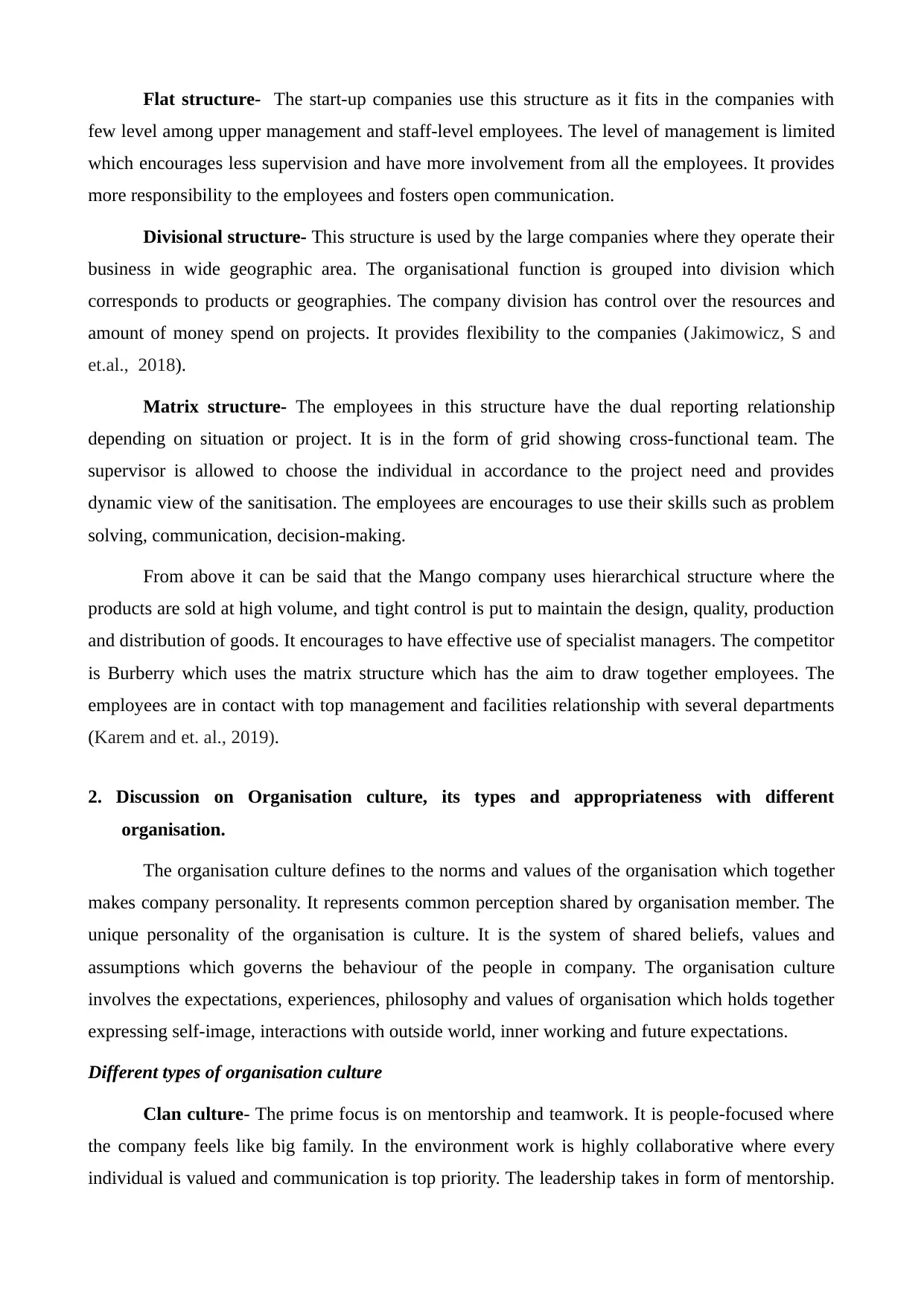
Flat structure- The start-up companies use this structure as it fits in the companies with
few level among upper management and staff-level employees. The level of management is limited
which encourages less supervision and have more involvement from all the employees. It provides
more responsibility to the employees and fosters open communication.
Divisional structure- This structure is used by the large companies where they operate their
business in wide geographic area. The organisational function is grouped into division which
corresponds to products or geographies. The company division has control over the resources and
amount of money spend on projects. It provides flexibility to the companies (Jakimowicz, S and
et.al., 2018).
Matrix structure- The employees in this structure have the dual reporting relationship
depending on situation or project. It is in the form of grid showing cross-functional team. The
supervisor is allowed to choose the individual in accordance to the project need and provides
dynamic view of the sanitisation. The employees are encourages to use their skills such as problem
solving, communication, decision-making.
From above it can be said that the Mango company uses hierarchical structure where the
products are sold at high volume, and tight control is put to maintain the design, quality, production
and distribution of goods. It encourages to have effective use of specialist managers. The competitor
is Burberry which uses the matrix structure which has the aim to draw together employees. The
employees are in contact with top management and facilities relationship with several departments
(Karem and et. al., 2019).
2. Discussion on Organisation culture, its types and appropriateness with different
organisation.
The organisation culture defines to the norms and values of the organisation which together
makes company personality. It represents common perception shared by organisation member. The
unique personality of the organisation is culture. It is the system of shared beliefs, values and
assumptions which governs the behaviour of the people in company. The organisation culture
involves the expectations, experiences, philosophy and values of organisation which holds together
expressing self-image, interactions with outside world, inner working and future expectations.
Different types of organisation culture
Clan culture- The prime focus is on mentorship and teamwork. It is people-focused where
the company feels like big family. In the environment work is highly collaborative where every
individual is valued and communication is top priority. The leadership takes in form of mentorship.
few level among upper management and staff-level employees. The level of management is limited
which encourages less supervision and have more involvement from all the employees. It provides
more responsibility to the employees and fosters open communication.
Divisional structure- This structure is used by the large companies where they operate their
business in wide geographic area. The organisational function is grouped into division which
corresponds to products or geographies. The company division has control over the resources and
amount of money spend on projects. It provides flexibility to the companies (Jakimowicz, S and
et.al., 2018).
Matrix structure- The employees in this structure have the dual reporting relationship
depending on situation or project. It is in the form of grid showing cross-functional team. The
supervisor is allowed to choose the individual in accordance to the project need and provides
dynamic view of the sanitisation. The employees are encourages to use their skills such as problem
solving, communication, decision-making.
From above it can be said that the Mango company uses hierarchical structure where the
products are sold at high volume, and tight control is put to maintain the design, quality, production
and distribution of goods. It encourages to have effective use of specialist managers. The competitor
is Burberry which uses the matrix structure which has the aim to draw together employees. The
employees are in contact with top management and facilities relationship with several departments
(Karem and et. al., 2019).
2. Discussion on Organisation culture, its types and appropriateness with different
organisation.
The organisation culture defines to the norms and values of the organisation which together
makes company personality. It represents common perception shared by organisation member. The
unique personality of the organisation is culture. It is the system of shared beliefs, values and
assumptions which governs the behaviour of the people in company. The organisation culture
involves the expectations, experiences, philosophy and values of organisation which holds together
expressing self-image, interactions with outside world, inner working and future expectations.
Different types of organisation culture
Clan culture- The prime focus is on mentorship and teamwork. It is people-focused where
the company feels like big family. In the environment work is highly collaborative where every
individual is valued and communication is top priority. The leadership takes in form of mentorship.
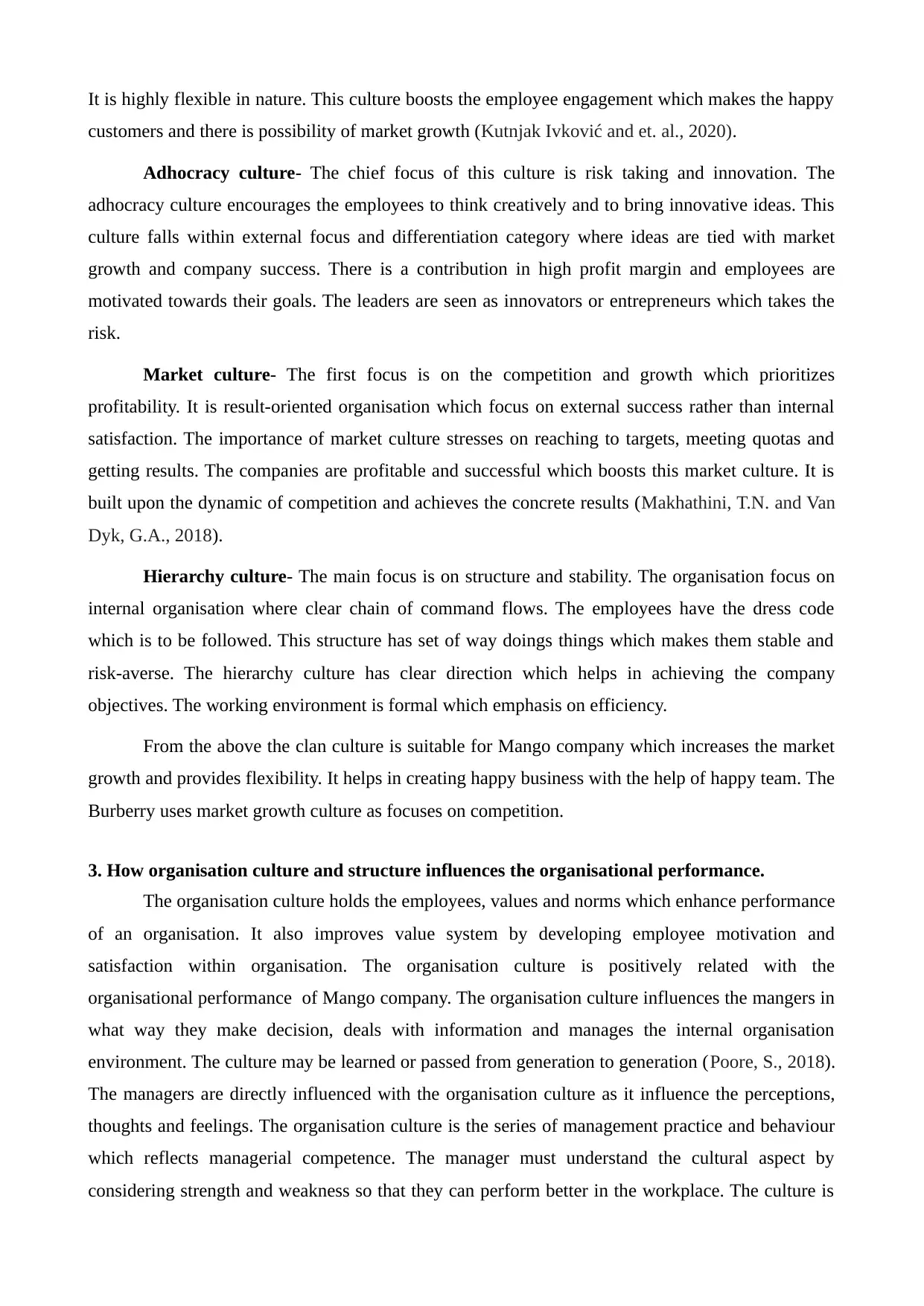
It is highly flexible in nature. This culture boosts the employee engagement which makes the happy
customers and there is possibility of market growth (Kutnjak Ivković and et. al., 2020).
Adhocracy culture- The chief focus of this culture is risk taking and innovation. The
adhocracy culture encourages the employees to think creatively and to bring innovative ideas. This
culture falls within external focus and differentiation category where ideas are tied with market
growth and company success. There is a contribution in high profit margin and employees are
motivated towards their goals. The leaders are seen as innovators or entrepreneurs which takes the
risk.
Market culture- The first focus is on the competition and growth which prioritizes
profitability. It is result-oriented organisation which focus on external success rather than internal
satisfaction. The importance of market culture stresses on reaching to targets, meeting quotas and
getting results. The companies are profitable and successful which boosts this market culture. It is
built upon the dynamic of competition and achieves the concrete results (Makhathini, T.N. and Van
Dyk, G.A., 2018).
Hierarchy culture- The main focus is on structure and stability. The organisation focus on
internal organisation where clear chain of command flows. The employees have the dress code
which is to be followed. This structure has set of way doings things which makes them stable and
risk-averse. The hierarchy culture has clear direction which helps in achieving the company
objectives. The working environment is formal which emphasis on efficiency.
From the above the clan culture is suitable for Mango company which increases the market
growth and provides flexibility. It helps in creating happy business with the help of happy team. The
Burberry uses market growth culture as focuses on competition.
3. How organisation culture and structure influences the organisational performance.
The organisation culture holds the employees, values and norms which enhance performance
of an organisation. It also improves value system by developing employee motivation and
satisfaction within organisation. The organisation culture is positively related with the
organisational performance of Mango company. The organisation culture influences the mangers in
what way they make decision, deals with information and manages the internal organisation
environment. The culture may be learned or passed from generation to generation (Poore, S., 2018).
The managers are directly influenced with the organisation culture as it influence the perceptions,
thoughts and feelings. The organisation culture is the series of management practice and behaviour
which reflects managerial competence. The manager must understand the cultural aspect by
considering strength and weakness so that they can perform better in the workplace. The culture is
customers and there is possibility of market growth (Kutnjak Ivković and et. al., 2020).
Adhocracy culture- The chief focus of this culture is risk taking and innovation. The
adhocracy culture encourages the employees to think creatively and to bring innovative ideas. This
culture falls within external focus and differentiation category where ideas are tied with market
growth and company success. There is a contribution in high profit margin and employees are
motivated towards their goals. The leaders are seen as innovators or entrepreneurs which takes the
risk.
Market culture- The first focus is on the competition and growth which prioritizes
profitability. It is result-oriented organisation which focus on external success rather than internal
satisfaction. The importance of market culture stresses on reaching to targets, meeting quotas and
getting results. The companies are profitable and successful which boosts this market culture. It is
built upon the dynamic of competition and achieves the concrete results (Makhathini, T.N. and Van
Dyk, G.A., 2018).
Hierarchy culture- The main focus is on structure and stability. The organisation focus on
internal organisation where clear chain of command flows. The employees have the dress code
which is to be followed. This structure has set of way doings things which makes them stable and
risk-averse. The hierarchy culture has clear direction which helps in achieving the company
objectives. The working environment is formal which emphasis on efficiency.
From the above the clan culture is suitable for Mango company which increases the market
growth and provides flexibility. It helps in creating happy business with the help of happy team. The
Burberry uses market growth culture as focuses on competition.
3. How organisation culture and structure influences the organisational performance.
The organisation culture holds the employees, values and norms which enhance performance
of an organisation. It also improves value system by developing employee motivation and
satisfaction within organisation. The organisation culture is positively related with the
organisational performance of Mango company. The organisation culture influences the mangers in
what way they make decision, deals with information and manages the internal organisation
environment. The culture may be learned or passed from generation to generation (Poore, S., 2018).
The managers are directly influenced with the organisation culture as it influence the perceptions,
thoughts and feelings. The organisation culture is the series of management practice and behaviour
which reflects managerial competence. The manager must understand the cultural aspect by
considering strength and weakness so that they can perform better in the workplace. The culture is
⊘ This is a preview!⊘
Do you want full access?
Subscribe today to unlock all pages.

Trusted by 1+ million students worldwide
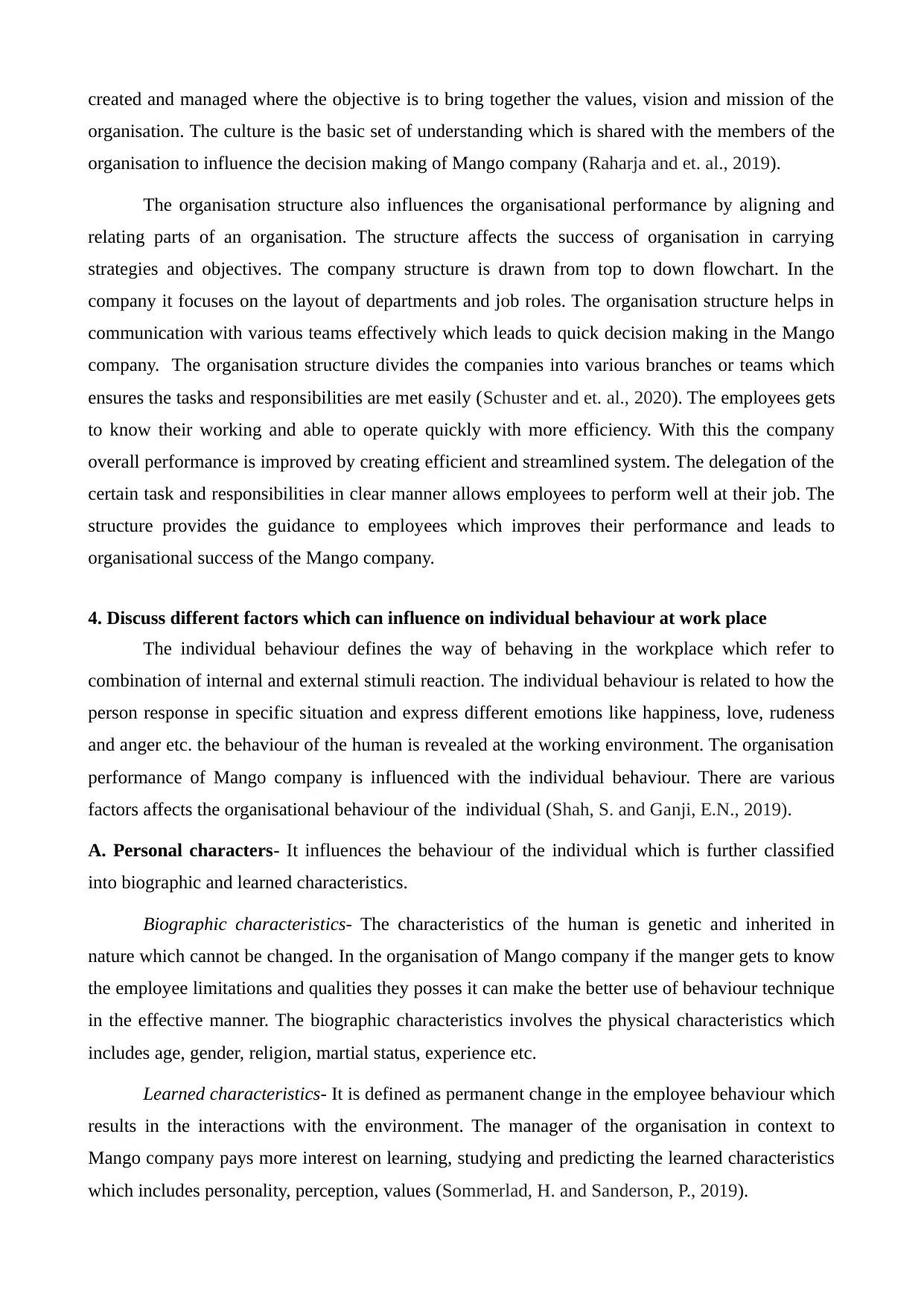
created and managed where the objective is to bring together the values, vision and mission of the
organisation. The culture is the basic set of understanding which is shared with the members of the
organisation to influence the decision making of Mango company (Raharja and et. al., 2019).
The organisation structure also influences the organisational performance by aligning and
relating parts of an organisation. The structure affects the success of organisation in carrying
strategies and objectives. The company structure is drawn from top to down flowchart. In the
company it focuses on the layout of departments and job roles. The organisation structure helps in
communication with various teams effectively which leads to quick decision making in the Mango
company. The organisation structure divides the companies into various branches or teams which
ensures the tasks and responsibilities are met easily (Schuster and et. al., 2020). The employees gets
to know their working and able to operate quickly with more efficiency. With this the company
overall performance is improved by creating efficient and streamlined system. The delegation of the
certain task and responsibilities in clear manner allows employees to perform well at their job. The
structure provides the guidance to employees which improves their performance and leads to
organisational success of the Mango company.
4. Discuss different factors which can influence on individual behaviour at work place
The individual behaviour defines the way of behaving in the workplace which refer to
combination of internal and external stimuli reaction. The individual behaviour is related to how the
person response in specific situation and express different emotions like happiness, love, rudeness
and anger etc. the behaviour of the human is revealed at the working environment. The organisation
performance of Mango company is influenced with the individual behaviour. There are various
factors affects the organisational behaviour of the individual (Shah, S. and Ganji, E.N., 2019).
A. Personal characters- It influences the behaviour of the individual which is further classified
into biographic and learned characteristics.
Biographic characteristics- The characteristics of the human is genetic and inherited in
nature which cannot be changed. In the organisation of Mango company if the manger gets to know
the employee limitations and qualities they posses it can make the better use of behaviour technique
in the effective manner. The biographic characteristics involves the physical characteristics which
includes age, gender, religion, martial status, experience etc.
Learned characteristics- It is defined as permanent change in the employee behaviour which
results in the interactions with the environment. The manager of the organisation in context to
Mango company pays more interest on learning, studying and predicting the learned characteristics
which includes personality, perception, values (Sommerlad, H. and Sanderson, P., 2019).
organisation. The culture is the basic set of understanding which is shared with the members of the
organisation to influence the decision making of Mango company (Raharja and et. al., 2019).
The organisation structure also influences the organisational performance by aligning and
relating parts of an organisation. The structure affects the success of organisation in carrying
strategies and objectives. The company structure is drawn from top to down flowchart. In the
company it focuses on the layout of departments and job roles. The organisation structure helps in
communication with various teams effectively which leads to quick decision making in the Mango
company. The organisation structure divides the companies into various branches or teams which
ensures the tasks and responsibilities are met easily (Schuster and et. al., 2020). The employees gets
to know their working and able to operate quickly with more efficiency. With this the company
overall performance is improved by creating efficient and streamlined system. The delegation of the
certain task and responsibilities in clear manner allows employees to perform well at their job. The
structure provides the guidance to employees which improves their performance and leads to
organisational success of the Mango company.
4. Discuss different factors which can influence on individual behaviour at work place
The individual behaviour defines the way of behaving in the workplace which refer to
combination of internal and external stimuli reaction. The individual behaviour is related to how the
person response in specific situation and express different emotions like happiness, love, rudeness
and anger etc. the behaviour of the human is revealed at the working environment. The organisation
performance of Mango company is influenced with the individual behaviour. There are various
factors affects the organisational behaviour of the individual (Shah, S. and Ganji, E.N., 2019).
A. Personal characters- It influences the behaviour of the individual which is further classified
into biographic and learned characteristics.
Biographic characteristics- The characteristics of the human is genetic and inherited in
nature which cannot be changed. In the organisation of Mango company if the manger gets to know
the employee limitations and qualities they posses it can make the better use of behaviour technique
in the effective manner. The biographic characteristics involves the physical characteristics which
includes age, gender, religion, martial status, experience etc.
Learned characteristics- It is defined as permanent change in the employee behaviour which
results in the interactions with the environment. The manager of the organisation in context to
Mango company pays more interest on learning, studying and predicting the learned characteristics
which includes personality, perception, values (Sommerlad, H. and Sanderson, P., 2019).
Paraphrase This Document
Need a fresh take? Get an instant paraphrase of this document with our AI Paraphraser
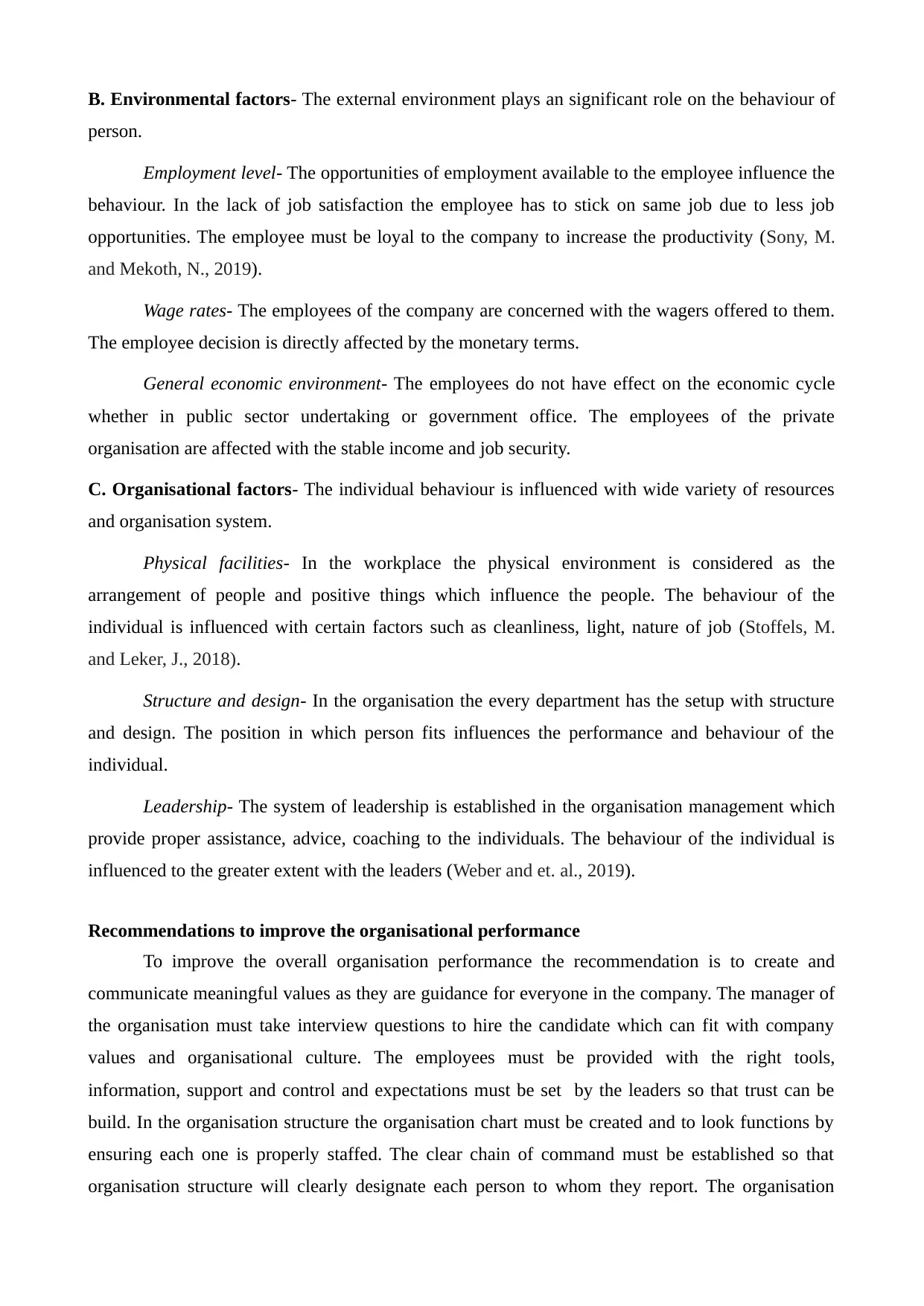
B. Environmental factors- The external environment plays an significant role on the behaviour of
person.
Employment level- The opportunities of employment available to the employee influence the
behaviour. In the lack of job satisfaction the employee has to stick on same job due to less job
opportunities. The employee must be loyal to the company to increase the productivity (Sony, M.
and Mekoth, N., 2019).
Wage rates- The employees of the company are concerned with the wagers offered to them.
The employee decision is directly affected by the monetary terms.
General economic environment- The employees do not have effect on the economic cycle
whether in public sector undertaking or government office. The employees of the private
organisation are affected with the stable income and job security.
C. Organisational factors- The individual behaviour is influenced with wide variety of resources
and organisation system.
Physical facilities- In the workplace the physical environment is considered as the
arrangement of people and positive things which influence the people. The behaviour of the
individual is influenced with certain factors such as cleanliness, light, nature of job (Stoffels, M.
and Leker, J., 2018).
Structure and design- In the organisation the every department has the setup with structure
and design. The position in which person fits influences the performance and behaviour of the
individual.
Leadership- The system of leadership is established in the organisation management which
provide proper assistance, advice, coaching to the individuals. The behaviour of the individual is
influenced to the greater extent with the leaders (Weber and et. al., 2019).
Recommendations to improve the organisational performance
To improve the overall organisation performance the recommendation is to create and
communicate meaningful values as they are guidance for everyone in the company. The manager of
the organisation must take interview questions to hire the candidate which can fit with company
values and organisational culture. The employees must be provided with the right tools,
information, support and control and expectations must be set by the leaders so that trust can be
build. In the organisation structure the organisation chart must be created and to look functions by
ensuring each one is properly staffed. The clear chain of command must be established so that
organisation structure will clearly designate each person to whom they report. The organisation
person.
Employment level- The opportunities of employment available to the employee influence the
behaviour. In the lack of job satisfaction the employee has to stick on same job due to less job
opportunities. The employee must be loyal to the company to increase the productivity (Sony, M.
and Mekoth, N., 2019).
Wage rates- The employees of the company are concerned with the wagers offered to them.
The employee decision is directly affected by the monetary terms.
General economic environment- The employees do not have effect on the economic cycle
whether in public sector undertaking or government office. The employees of the private
organisation are affected with the stable income and job security.
C. Organisational factors- The individual behaviour is influenced with wide variety of resources
and organisation system.
Physical facilities- In the workplace the physical environment is considered as the
arrangement of people and positive things which influence the people. The behaviour of the
individual is influenced with certain factors such as cleanliness, light, nature of job (Stoffels, M.
and Leker, J., 2018).
Structure and design- In the organisation the every department has the setup with structure
and design. The position in which person fits influences the performance and behaviour of the
individual.
Leadership- The system of leadership is established in the organisation management which
provide proper assistance, advice, coaching to the individuals. The behaviour of the individual is
influenced to the greater extent with the leaders (Weber and et. al., 2019).
Recommendations to improve the organisational performance
To improve the overall organisation performance the recommendation is to create and
communicate meaningful values as they are guidance for everyone in the company. The manager of
the organisation must take interview questions to hire the candidate which can fit with company
values and organisational culture. The employees must be provided with the right tools,
information, support and control and expectations must be set by the leaders so that trust can be
build. In the organisation structure the organisation chart must be created and to look functions by
ensuring each one is properly staffed. The clear chain of command must be established so that
organisation structure will clearly designate each person to whom they report. The organisation
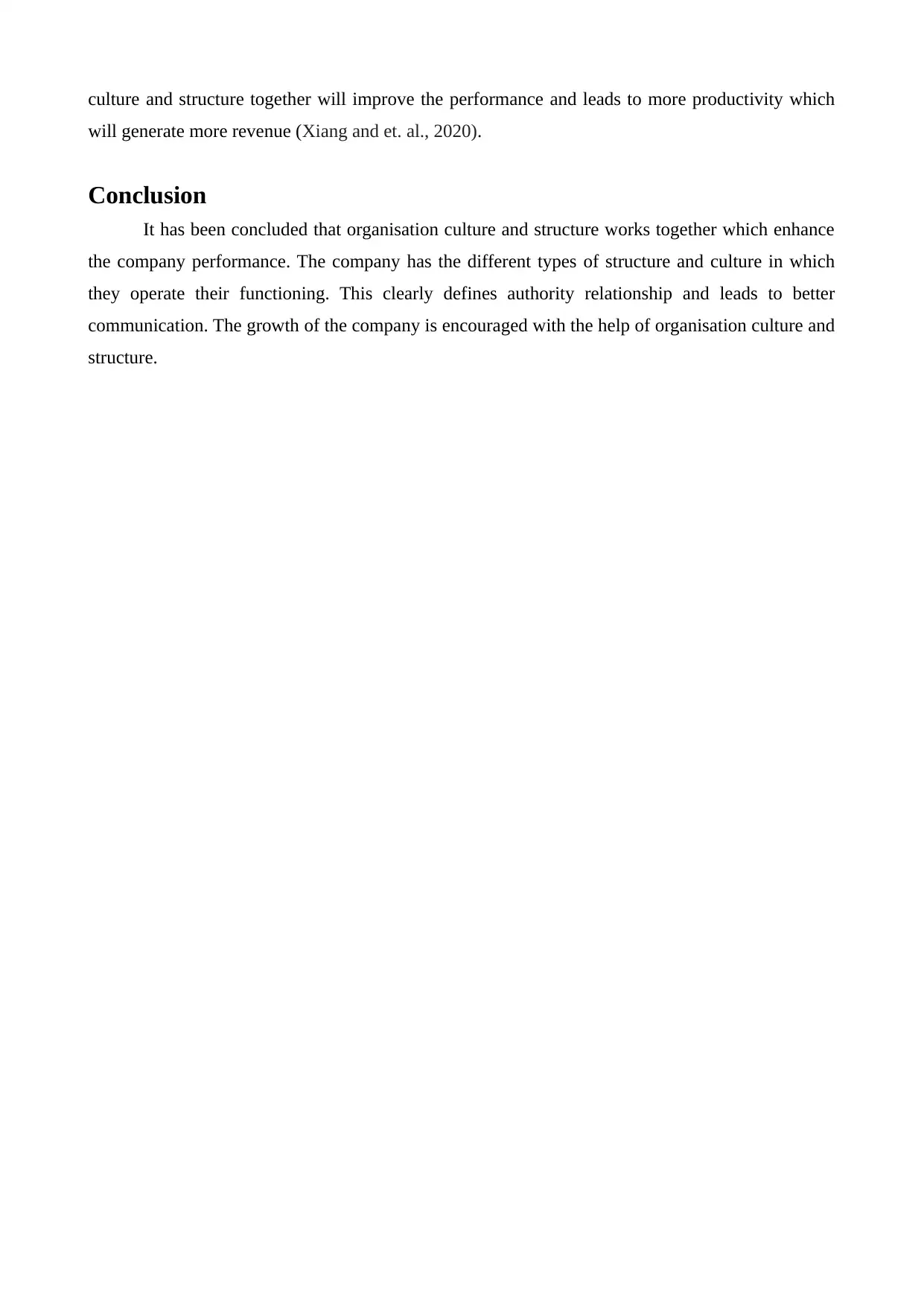
culture and structure together will improve the performance and leads to more productivity which
will generate more revenue (Xiang and et. al., 2020).
Conclusion
It has been concluded that organisation culture and structure works together which enhance
the company performance. The company has the different types of structure and culture in which
they operate their functioning. This clearly defines authority relationship and leads to better
communication. The growth of the company is encouraged with the help of organisation culture and
structure.
will generate more revenue (Xiang and et. al., 2020).
Conclusion
It has been concluded that organisation culture and structure works together which enhance
the company performance. The company has the different types of structure and culture in which
they operate their functioning. This clearly defines authority relationship and leads to better
communication. The growth of the company is encouraged with the help of organisation culture and
structure.
⊘ This is a preview!⊘
Do you want full access?
Subscribe today to unlock all pages.

Trusted by 1+ million students worldwide
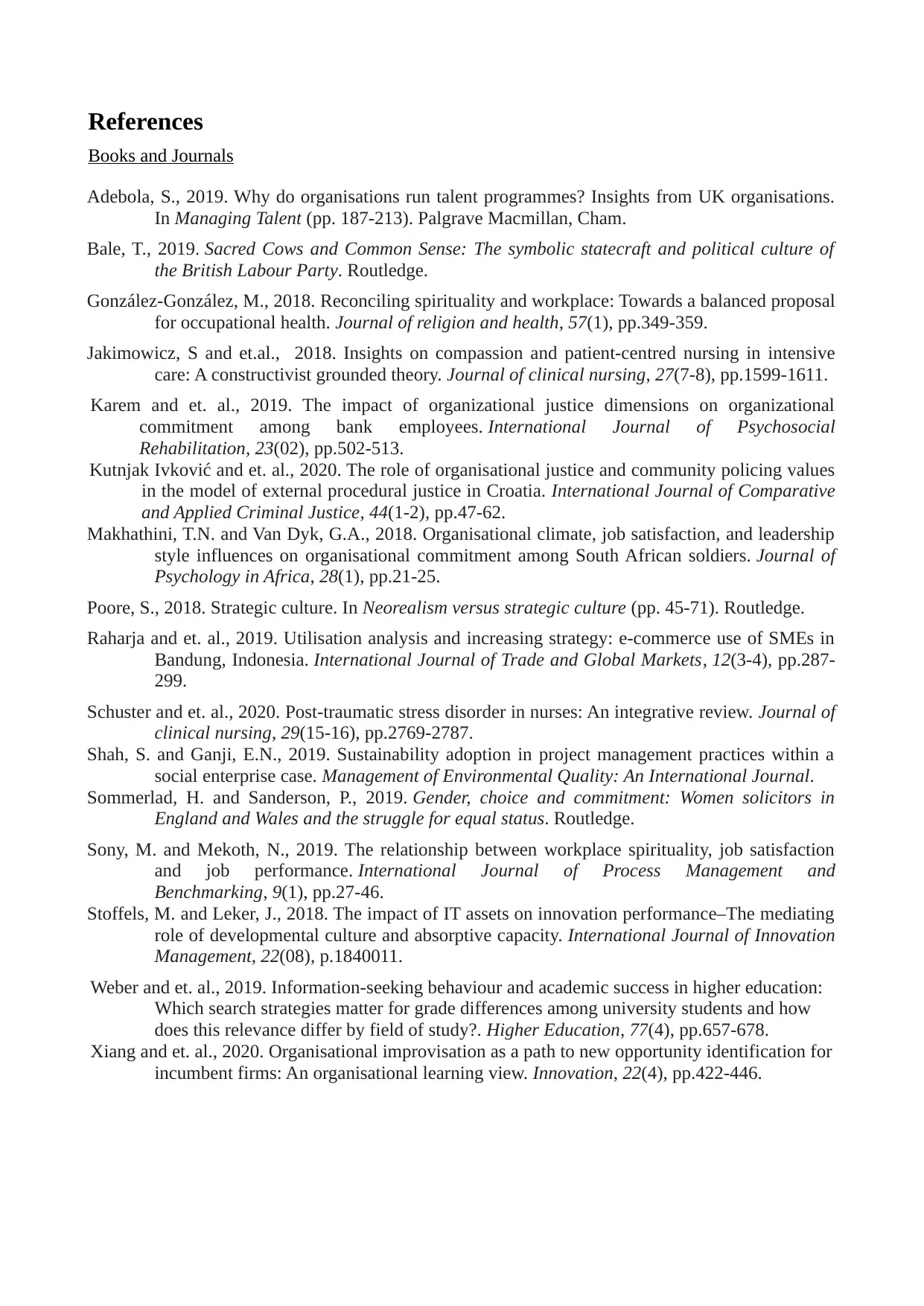
References
Books and Journals
Adebola, S., 2019. Why do organisations run talent programmes? Insights from UK organisations.
In Managing Talent (pp. 187-213). Palgrave Macmillan, Cham.
Bale, T., 2019. Sacred Cows and Common Sense: The symbolic statecraft and political culture of
the British Labour Party. Routledge.
González-González, M., 2018. Reconciling spirituality and workplace: Towards a balanced proposal
for occupational health. Journal of religion and health, 57(1), pp.349-359.
Jakimowicz, S and et.al., 2018. Insights on compassion and patient‐centred nursing in intensive
care: A constructivist grounded theory. Journal of clinical nursing, 27(7-8), pp.1599-1611.
Karem and et. al., 2019. The impact of organizational justice dimensions on organizational
commitment among bank employees. International Journal of Psychosocial
Rehabilitation, 23(02), pp.502-513.
Kutnjak Ivković and et. al., 2020. The role of organisational justice and community policing values
in the model of external procedural justice in Croatia. International Journal of Comparative
and Applied Criminal Justice, 44(1-2), pp.47-62.
Makhathini, T.N. and Van Dyk, G.A., 2018. Organisational climate, job satisfaction, and leadership
style influences on organisational commitment among South African soldiers. Journal of
Psychology in Africa, 28(1), pp.21-25.
Poore, S., 2018. Strategic culture. In Neorealism versus strategic culture (pp. 45-71). Routledge.
Raharja and et. al., 2019. Utilisation analysis and increasing strategy: e-commerce use of SMEs in
Bandung, Indonesia. International Journal of Trade and Global Markets, 12(3-4), pp.287-
299.
Schuster and et. al., 2020. Post‐traumatic stress disorder in nurses: An integrative review. Journal of
clinical nursing, 29(15-16), pp.2769-2787.
Shah, S. and Ganji, E.N., 2019. Sustainability adoption in project management practices within a
social enterprise case. Management of Environmental Quality: An International Journal.
Sommerlad, H. and Sanderson, P., 2019. Gender, choice and commitment: Women solicitors in
England and Wales and the struggle for equal status. Routledge.
Sony, M. and Mekoth, N., 2019. The relationship between workplace spirituality, job satisfaction
and job performance. International Journal of Process Management and
Benchmarking, 9(1), pp.27-46.
Stoffels, M. and Leker, J., 2018. The impact of IT assets on innovation performance–The mediating
role of developmental culture and absorptive capacity. International Journal of Innovation
Management, 22(08), p.1840011.
Weber and et. al., 2019. Information-seeking behaviour and academic success in higher education:
Which search strategies matter for grade differences among university students and how
does this relevance differ by field of study?. Higher Education, 77(4), pp.657-678.
Xiang and et. al., 2020. Organisational improvisation as a path to new opportunity identification for
incumbent firms: An organisational learning view. Innovation, 22(4), pp.422-446.
Books and Journals
Adebola, S., 2019. Why do organisations run talent programmes? Insights from UK organisations.
In Managing Talent (pp. 187-213). Palgrave Macmillan, Cham.
Bale, T., 2019. Sacred Cows and Common Sense: The symbolic statecraft and political culture of
the British Labour Party. Routledge.
González-González, M., 2018. Reconciling spirituality and workplace: Towards a balanced proposal
for occupational health. Journal of religion and health, 57(1), pp.349-359.
Jakimowicz, S and et.al., 2018. Insights on compassion and patient‐centred nursing in intensive
care: A constructivist grounded theory. Journal of clinical nursing, 27(7-8), pp.1599-1611.
Karem and et. al., 2019. The impact of organizational justice dimensions on organizational
commitment among bank employees. International Journal of Psychosocial
Rehabilitation, 23(02), pp.502-513.
Kutnjak Ivković and et. al., 2020. The role of organisational justice and community policing values
in the model of external procedural justice in Croatia. International Journal of Comparative
and Applied Criminal Justice, 44(1-2), pp.47-62.
Makhathini, T.N. and Van Dyk, G.A., 2018. Organisational climate, job satisfaction, and leadership
style influences on organisational commitment among South African soldiers. Journal of
Psychology in Africa, 28(1), pp.21-25.
Poore, S., 2018. Strategic culture. In Neorealism versus strategic culture (pp. 45-71). Routledge.
Raharja and et. al., 2019. Utilisation analysis and increasing strategy: e-commerce use of SMEs in
Bandung, Indonesia. International Journal of Trade and Global Markets, 12(3-4), pp.287-
299.
Schuster and et. al., 2020. Post‐traumatic stress disorder in nurses: An integrative review. Journal of
clinical nursing, 29(15-16), pp.2769-2787.
Shah, S. and Ganji, E.N., 2019. Sustainability adoption in project management practices within a
social enterprise case. Management of Environmental Quality: An International Journal.
Sommerlad, H. and Sanderson, P., 2019. Gender, choice and commitment: Women solicitors in
England and Wales and the struggle for equal status. Routledge.
Sony, M. and Mekoth, N., 2019. The relationship between workplace spirituality, job satisfaction
and job performance. International Journal of Process Management and
Benchmarking, 9(1), pp.27-46.
Stoffels, M. and Leker, J., 2018. The impact of IT assets on innovation performance–The mediating
role of developmental culture and absorptive capacity. International Journal of Innovation
Management, 22(08), p.1840011.
Weber and et. al., 2019. Information-seeking behaviour and academic success in higher education:
Which search strategies matter for grade differences among university students and how
does this relevance differ by field of study?. Higher Education, 77(4), pp.657-678.
Xiang and et. al., 2020. Organisational improvisation as a path to new opportunity identification for
incumbent firms: An organisational learning view. Innovation, 22(4), pp.422-446.
Paraphrase This Document
Need a fresh take? Get an instant paraphrase of this document with our AI Paraphraser

1 out of 11
Related Documents
Your All-in-One AI-Powered Toolkit for Academic Success.
+13062052269
info@desklib.com
Available 24*7 on WhatsApp / Email
![[object Object]](/_next/static/media/star-bottom.7253800d.svg)
Unlock your academic potential
Copyright © 2020–2025 A2Z Services. All Rights Reserved. Developed and managed by ZUCOL.





